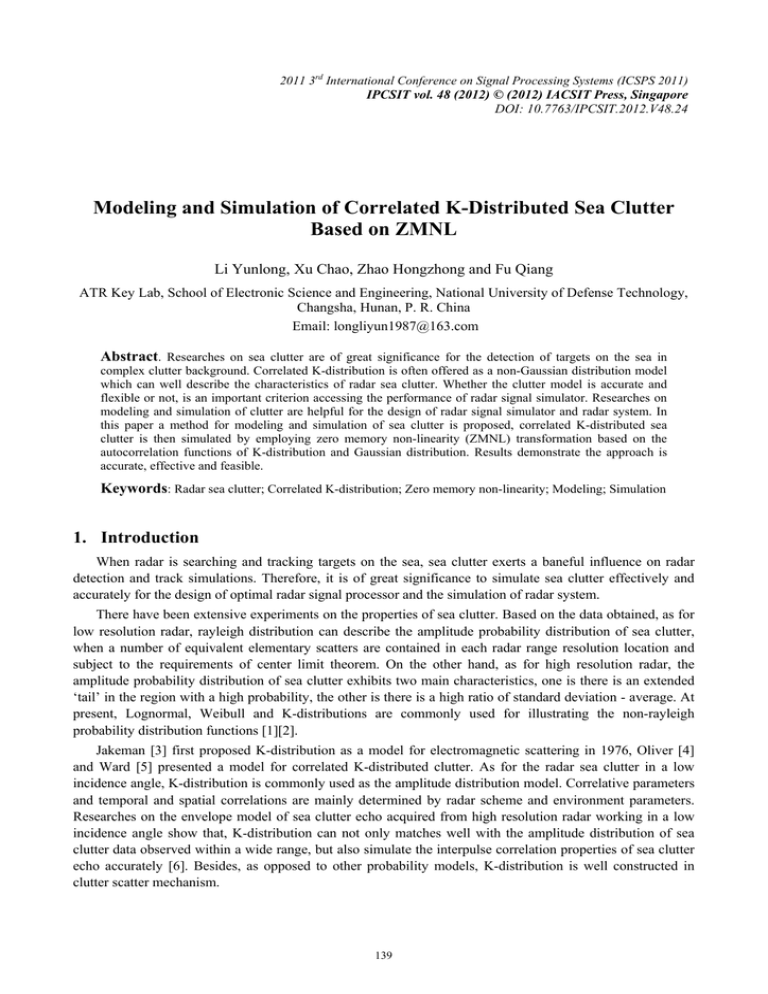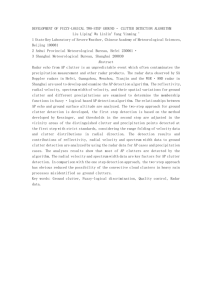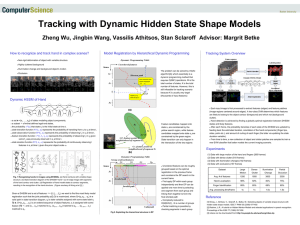Document 13136659
advertisement

2011 3rd International Conference on Signal Processing Systems (ICSPS 2011)
IPCSIT vol. 48 (2012) © (2012) IACSIT Press, Singapore
DOI: 10.7763/IPCSIT.2012.V48.24
Modeling and Simulation of Correlated K-Distributed Sea Clutter
Based on ZMNL
Li Yunlong, Xu Chao, Zhao Hongzhong and Fu Qiang
ATR Key Lab, School of Electronic Science and Engineering, National University of Defense Technology,
Changsha, Hunan, P. R. China
Email: longliyun1987@163.com
Abstract. Researches on sea clutter are of great significance for the detection of targets on the sea in
complex clutter background. Correlated K-distribution is often offered as a non-Gaussian distribution model
which can well describe the characteristics of radar sea clutter. Whether the clutter model is accurate and
flexible or not, is an important criterion accessing the performance of radar signal simulator. Researches on
modeling and simulation of clutter are helpful for the design of radar signal simulator and radar system. In
this paper a method for modeling and simulation of sea clutter is proposed, correlated K-distributed sea
clutter is then simulated by employing zero memory non-linearity (ZMNL) transformation based on the
autocorrelation functions of K-distribution and Gaussian distribution. Results demonstrate the approach is
accurate, effective and feasible.
Keywords: Radar sea clutter; Correlated K-distribution; Zero memory non-linearity; Modeling; Simulation
1. Introduction
When radar is searching and tracking targets on the sea, sea clutter exerts a baneful influence on radar
detection and track simulations. Therefore, it is of great significance to simulate sea clutter effectively and
accurately for the design of optimal radar signal processor and the simulation of radar system.
There have been extensive experiments on the properties of sea clutter. Based on the data obtained, as for
low resolution radar, rayleigh distribution can describe the amplitude probability distribution of sea clutter,
when a number of equivalent elementary scatters are contained in each radar range resolution location and
subject to the requirements of center limit theorem. On the other hand, as for high resolution radar, the
amplitude probability distribution of sea clutter exhibits two main characteristics, one is there is an extended
‘tail’ in the region with a high probability, the other is there is a high ratio of standard deviation - average. At
present, Lognormal, Weibull and K-distributions are commonly used for illustrating the non-rayleigh
probability distribution functions [1][2].
Jakeman [3] first proposed K-distribution as a model for electromagnetic scattering in 1976, Oliver [4]
and Ward [5] presented a model for correlated K-distributed clutter. As for the radar sea clutter in a low
incidence angle, K-distribution is commonly used as the amplitude distribution model. Correlative parameters
and temporal and spatial correlations are mainly determined by radar scheme and environment parameters.
Researches on the envelope model of sea clutter echo acquired from high resolution radar working in a low
incidence angle show that, K-distribution can not only matches well with the amplitude distribution of sea
clutter data observed within a wide range, but also simulate the interpulse correlation properties of sea clutter
echo accurately [6]. Besides, as opposed to other probability models, K-distribution is well constructed in
clutter scatter mechanism.
139
In this paper we present a method of modeling and simulating sea clutter based on zero memory nonlinear (ZMNL) correlated K-distributed clutter, and explain the whole implementation process. Correlated Kdistributed sea clutter generated by ZMNL is mainly studied. At last, radar sea clutter is simulated and the
results are analyzed. Simulation results demonstrate the validity of the algorithm.
2. Radar Sea Clutter Modeling
The modeling of radar sea clutter mainly include two aspects, one is to ascertain the amplitude distribution
and power spectrum of sea clutter, the other is to ascertain the parameters of amplitude distribution and power
spectrum model in accordance with concrete radar scheme and working environment.
2.1. Amplitude Distribution Model
Correlated K-distribution provides a wide available range, which is suitable for different types of radar sea
clutter. Meanwhile, K-distribution can not only simulate the extended ‘tail’ of amplitude distribution of sea
clutter, but also simulate the temporal and spatial correlation properties of sea clutter. According to the
correlated K-distributed clutter scatter mechanism, K-distribution model consists of two parts which contain
different clutter fluctuations, one is the slow-varying variables based on amplitude modulation, which are
often denoted by the Gamma distribution, the other is the fast-varying variables based on speckle distribution
determined by the multipath-clutter scatter properties within any range unit, which are often linked by the
internal motion of scatters. Therefore, we can regard the correlated K-distribution as a compound Gaussian
process, with which the power is modulated by the random process with Gamma distribution. The probability
density function is denoted as [6]:
p (γ ) = K [γ ; a, v] =
2
⎛ γ ⎞
⎜ ⎟
aΓ(v + 1) ⎝ 2a ⎠
v +1
⎛γ ⎞
K v ⎜ ⎟ , γ > 0, v > −1
⎝a⎠
(1)
where a is the scale parameter, which is determined by the average power of clutter, v is the shape parameter,
which shows the skewness of K-distribution, Γ(⋅) is the Gamma function, K v ( x) is the modified Bessel
function of order v .
2.2. Spectrum Model and Correlative Parameters
Sea clutter fluctuates slowly and has a high pulsed correlation, which is often described by the power
spectrum. In the radar sea clutter simulation an instance of models adopted belong to Gaussian distribution or
approximate Gaussian distribution. Take Gaussian spectrum for example, it is always defined by the half
width of power spectrum, which is denoted as:
S ( f ) = exp{−a[( f − f 0 ) / f 3dB ]2 }
(2)
where f 0 is the maximum spectrum, f 3dB is the half width of power spectrum determined by the average
speed of ocean wave and the radar wavelength, a is adopted as constant 1.665.
3. Radar Sea Clutter Simulation
Since the amplitude probability distribution and power spectrum model of sea clutter are determined, in
order to simulate sea clutter, the first is to generate a group of correlated K-distributed random sequences.
Spherically invariant random process (SIRP) [7] and zero memory non-linearity (ZMNL) [8] approaches are
commonly used to generate correlated random variables (RVs) with a certain probability distribution. As the
SIRP approach is restricted by the sequence orders and autocorrelation function, it is very difficult to form a
fast algorithm for large operation. Therefore, ZMNL approach is often used to simulate correlated radar clutter,
of which the main idea is to generate a correlated Gaussian random process, and then to generate correlated
RVs via non-linear transformation.
3.1. Correlated Gaussian Random Sequence Generation
In order to generate clutter sequences, uncorrelated Gaussian RVs are firstly passed through linear filters
to generate correlated Gaussian RVs. Linear filters can be synthesized in time and frequency domain. It is
difficult to deal with a long random sequence in the time domain, thereby correlated Gaussian RVs are always
generated in the frequency domain. Fig. 1 shows the generation of correlated Gaussian RVs.
140
X ~ N(0,1)
X (ω)
FFT
Sw (ω)
r(n)
R ( ω)
FFT
IFFT
W ~ N(0,1)
( •)
1/ r(0)
Fig.1. Generation of correlated Gaussian random variables
As is shown in Fig. 1, correlated coefficient sequence r (n) is first transformed into R(ω ) using FFT, and
then the amplitude of linear filter is computed as H (ω ) = R(ω ) / r (0) . Meanwhile, uncorrelated Gaussian
sequence x(n) is transformed into X (ω ) . The spectral density of correlated Gaussian sequence is deserved by
a linear product, which is denoted as Sw(ω) = H(ω) 2 ⋅ X(ω) = R(ω)/ r(0) . The correlated Gaussian RVs are finally
received by transforming S w (ω ) into time domain using IFFT, with which the spectral density is R(ω ) / r (0) .
3.2. Correlated K-distributed Sea Clutter Generation
The power spectrum of sea clutter z 2 can be denoted as a product of two RVs z 2 = XY , where X submits
to speckle distribution, Y submits to Chi distribution.
Fig. 2 shows the generation of K-distributed clutter RVs by employing ZMNL algorithm. The RVs
V1, j , V2, j ⋅⋅⋅ Vθ + 2, j , are independent, uncorrelated and identically distributed. A total of θ + 2 RVs are processed
as follows: the first θ comprise the random variable Y j , and the remaining two comprise the exponentially
distributed random variable X j . It is easy to show that the K-distributed probability density function of Z j is
formed from the product of the square roots of X j and Y j . It is now necessary to define the two
filters H1 (ω ) and H 2 (ω ) so that Z j is properly correlated after being formed by the non-linear processing.
N (0, a 2 )
V1, j
W1, j
N (0, a 2 )
.
.
.
H 1 (ω )
Vθ , j
ri , j
.
.
.
Wθ , j
W θ2, j
(• )
Wθ +1, j
Vθ +1, j
H 1 (ω )
Vθ + 2, j
G ( y , 2a 2 , θ / 2 −1)
Yj
Z
2
j
(• )
Wθ2+1, j
X
j
si , j
K ( z , a, θ / 2 − 1)
Wθ2+ 2 , j
Wθ + 2, j
N (0,1)
N (0,1)
W 1,2j
.
.
.
qi, j
Fig.2. Generation of K-distributed clutter
H (ω ) is found as follows. First, a realization of Z j beginning with zero mean, Gaussian distributed RVs is
needed. Second, the specified correlation coefficient for Z j , si , j is computed using IFFT for the spectrum of Z j .
We define ri , j and qi , j as the correlation coefficients of the first θ and the remaining two random variables. In
[8], the expression describing the correlation coefficients is denoted as:
sij =
with Λ =
Λ 2 [ 2 F1 ( −1/ 2, −1/ 2; v + 1; rij2 ) 2 F1 (−1/ 2, −1/ 2;1; qij2 − 1)]
v +1 − Λ2
(3)
Γ(v + 3 / 2)Γ(3 / 2)
, where 2 F1 (⋅) is the Gaussian hypergeometric function, defined as:
Γ(v + 1)
2
F1 ( a , b ; c ; z ) =
Γ (c )
Γ ( a )Γ (b )
∞
∑
n=0
Γ ( a + n )Γ (b + n ) z n
Γ (c + n )
n!
(4)
As described above, the probabilities, moments, and correlation coefficients of the joint probability
density function for Z j are functions of two parameters: ri , j and qi , j . Clearly, when ri , j and qi , j are set in
different exponents, the resulting evaluation for the relation between si , j and ri , j shows a sharp distinction. The
nonlinearity can be decreased to minimum if we can set ri , j = qi , j . That is, to minimize the linearity between
the correlated Gaussian-distributed RVs and correlated K-distributed RVs spectrum.
We can see that the model employs θ random variables ( W1, j ,W2, j ,...,Wθ , j ) to form the Gamma distributed
random variable Y j , which is combined with the exponentially distributed random variable X j to find the Kdistributed Z j of order v = θ / 2 − 1 .
141
Because θ = 1, 2,..., the parameter v assumes half integer and integer values beginning with -1/2. While the
expressions for the probability density function and moments of Z are correct for any v , the generation of
correlated, K-distributed random variables is not defined for general v . We suspect that the model set forth in
Fig. 2 bounds the problem of clutter representation for general v . However, [9] reports on a method to extend
the results to general v for K-distributed, spatially correlated clutter.
j
4. Simulation Results and Analysis
As described in Section Ⅲ, correlated K-distributed random variables can be generated. What should be
addressed is that, as Gaussian spectrum is adopted, we often define the sampling interval as Δf = 2 f dB / N ,
where N is the length of clutter sequence. Generally speaking, Δf is often determined in accordance with
radar parameters.
To prove the validity of the method, we can simulate the K-distributed clutter. Simulation parameters are
set as follows: half width of power spectrum f 3dB = 60 Hz , shape parameter v = 1.5 , scale parameter a = 1 ,
sampling numbers N = 1024 . Fig. 3 shows the amplitude statistical distribution of sea clutter and Fig. 4 shows
the amplitude probability distribution of sea clutter, from which we can see that the amplitude probability
distribution demonstrates a good simulation performance. All is illustrated that K-distribution can simulate the
amplitude distribution of sea clutter accurately.
Amplitude statitical distribution of K-distributed clutter
Amplitude probability distribution
6
3.5
Amplitude probability density
Amplitude probability statistic
4
3
2
1
0
-0.1
Simulated probabilty distribution
Real probability distribution
3
5
2.5
2
1.5
1
0.5
0
0.1
0.2
0.3
0.4
0.5
Amplitude(dB)
0.6
0.7
0.8
0
0
0.9
Fig.3. Amplitude stastical distribution of K-distributed
clutter
0.1
0.2
0.3
0.4
0.5
Amplitude(dB)
0.6
0.7
0.8
0.9
Fig.4. Amplitude probability distribution
Clutter temporal correlation is often illustrated by the spectral density. Fig. 5 shows the clutter power
spectrum estimation by employing Burg approach, making a comparison with the real power spectrum. As is
shown, a high compatibility demonstrates employing K-distribution can effectively simulate the temporal
correlation properties of sea clutter. Fig. 6 shows the time-territory waveform of K-distributed clutter.
Power spectrum
Time-domain waveform of K-distribution clutter--real part
1
1
0.9
Amplitude--real part
Simulated K-distributed power spectrum
Real K-distributed power spectrum
0.7
0.6
0.5
0
-0.5
-1
0
0.2
0.4
0.6
0.8
0.5
1
time(s)
1.2
1.4
1.6
1.8
0.4
0.3
0.2
0.1
0
-0.5
-0.4
-0.3
-0.2
-0.1
0
0.1
Frequency(Hz)
0.2
0.3
0.4
0.5
Fig.5. Power spectrum
2
4
Time-domain waveform of K-distribution clutter--imaginary part
Amplitude--imaginary part
Power spectrum density
0.8
x 10
1
0.5
0
-0.5
-1
0
0.2
0.4
0.6
0.8
1
time(s)
1.2
1.4
1.6
1.8
2
4
x 10
Fig.6. Time-domain waveform of K-distributed clutter
As described above, we can conclude that the approach of employing ZMNL to generate correlated Kdistributed RVs is accurate, and can effectively simulate the amplitude distribution and temporal correlation
properties of sea clutter.
142
5. Conclusion
With the progressing development of modern radar technology, it is increasingly important to model and
simulate the radar clutter, which is also the prerequisite for the realization of radar optimum design. Correlated
K-distribution is one of the models recognized which can reflect the properties of radar sea clutter. In this
paper the correlated K-distribution model is analyzed and established, and then the model is simulated by
employing ZMNL approach. A high compatibility with the real results proves the validity of the method. The
correlated K-distributed sea clutter can be applied in the design of optimal radar signal processor and the
simulation of radar system.
6. References
[1] A. Farina, et al. High Resolution Sea Clutter Data: Stastical Analysis of Recorded Live Data[J]. IEE Proceedings–
Radar Sonar Navigation, 1997, 144(3): 121-130.
[2] D. J. Mclaughlin, N. Allan. High Resolution Polarimetric Radar Scattering Measurement of Low Grazing Angle
Sea Clutter[J]. IEEE Journal of Oceanic Engineering, 1995, 20(3):166-178.
[3] E. Jakeman, P. N. Puscy. A model for non–Rayleigh Sea Clutter[J]. IEEE Trans. On A. P. , 1976: 806-814.
[4] C. J. Oliver. Correlated K–Distributed Clutter Model[J]. Optica Acta, 1985, 32(12): 1515-1547.
[5] K. D. Ward. Compound Representation of High Resolution Sea Clutter[J]. Electronics Letters, 1981:561-563.
[6] S. Watts, et al. Radar Detection Prediction in Sea Clutter Using the Compound K-Distribution Model[J]. IEE
Proceedings-F, 1985, 132(6):613-620.
[7] M. Rangaswamy, D. Weiner. Computer Generation of Correlated non-Gaussian Radar Clutter[J]. IEEE Trans. On.
E. S. , 1995, 31:106-115.
[8] L. James, Marier. Correlated K-Distribution Clutter Generation for Radar Detection and Track[J]. IEEE Trans. On.
A. E. S. , 1995, 31(2):568-580.
[9] Armstrong, B. C. , and Griffiths, H. D. (1991). Modeling Spatially Correlated K-Distributed Clutter. Electronics
Letters, 27, 15(July 18, 1991), 1355-1356.
143






